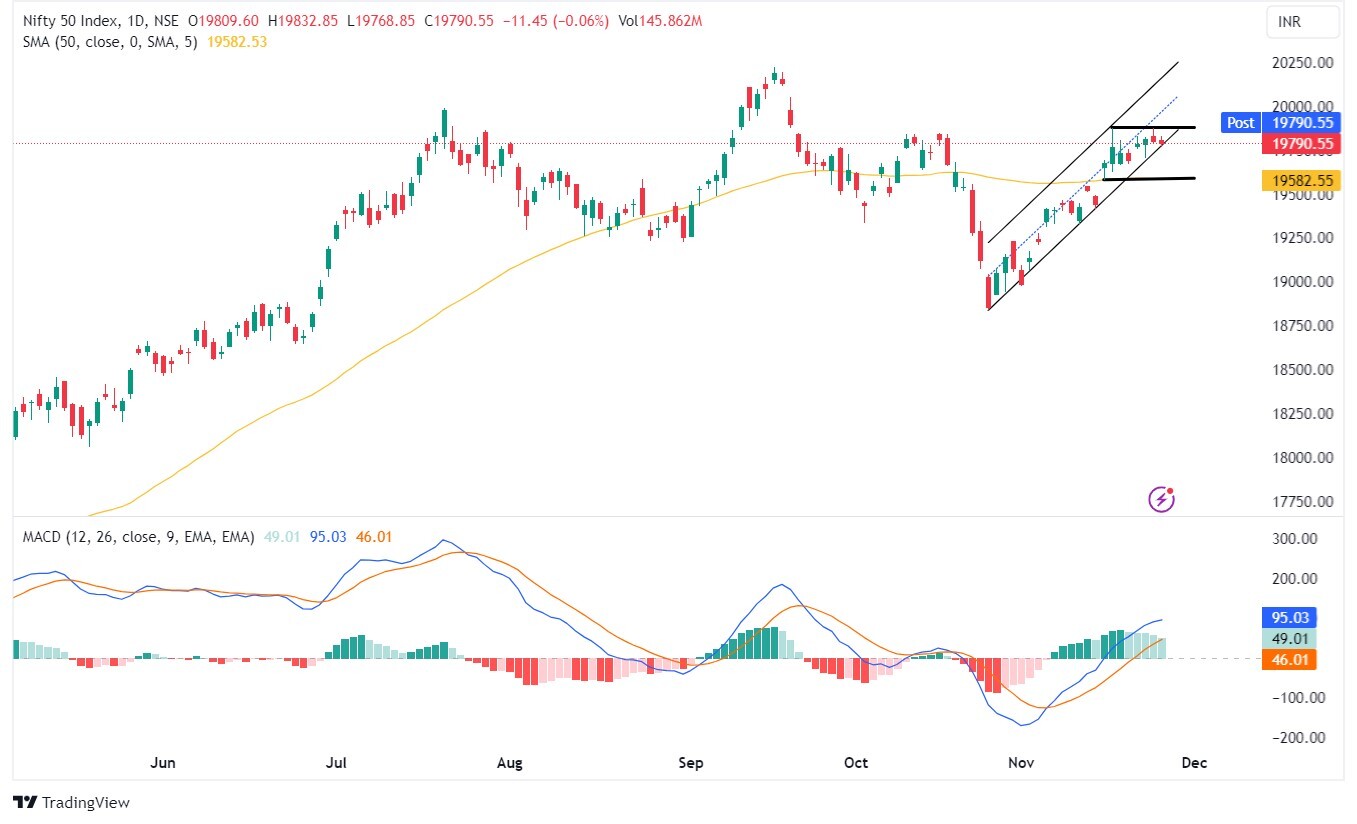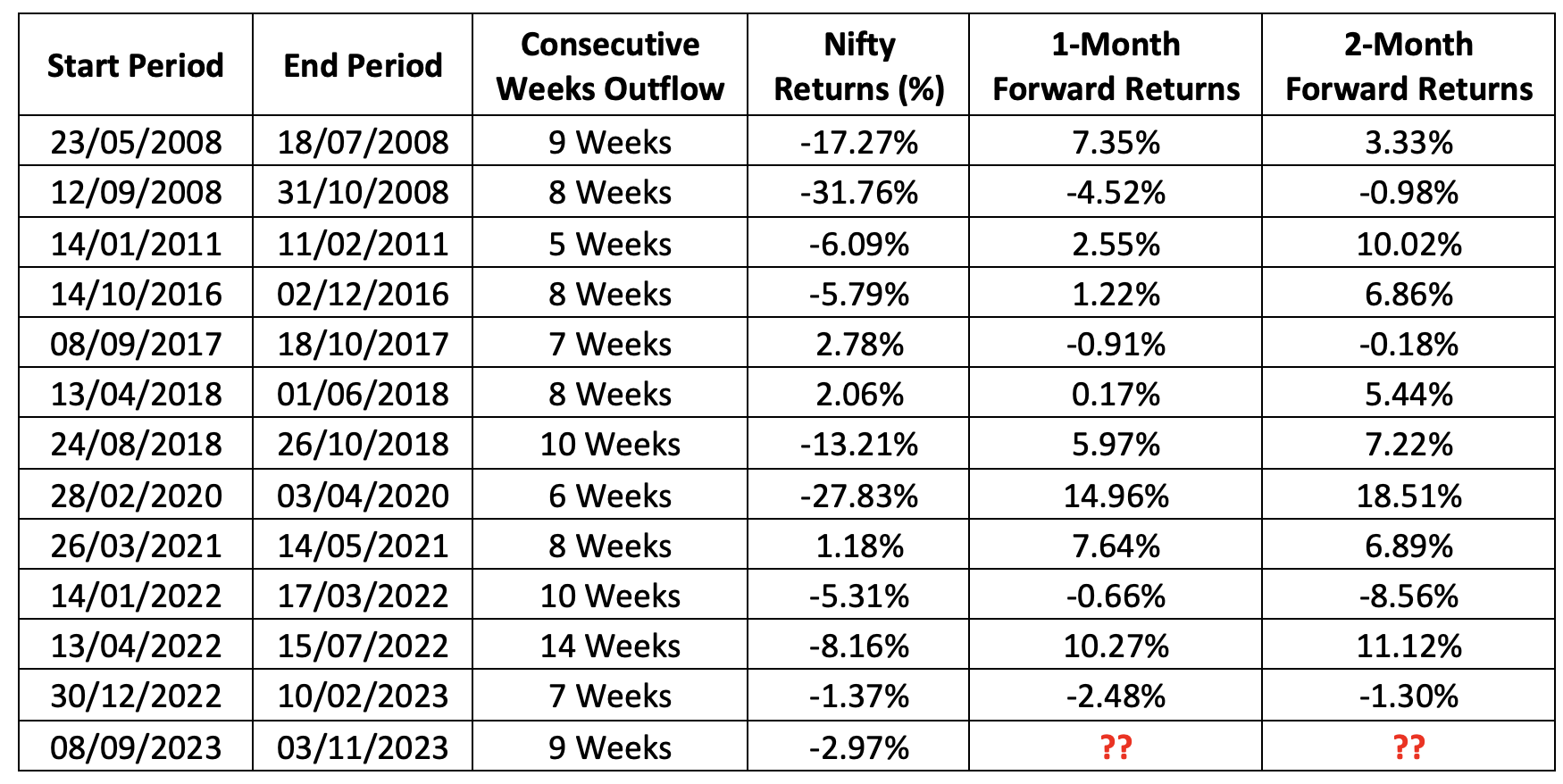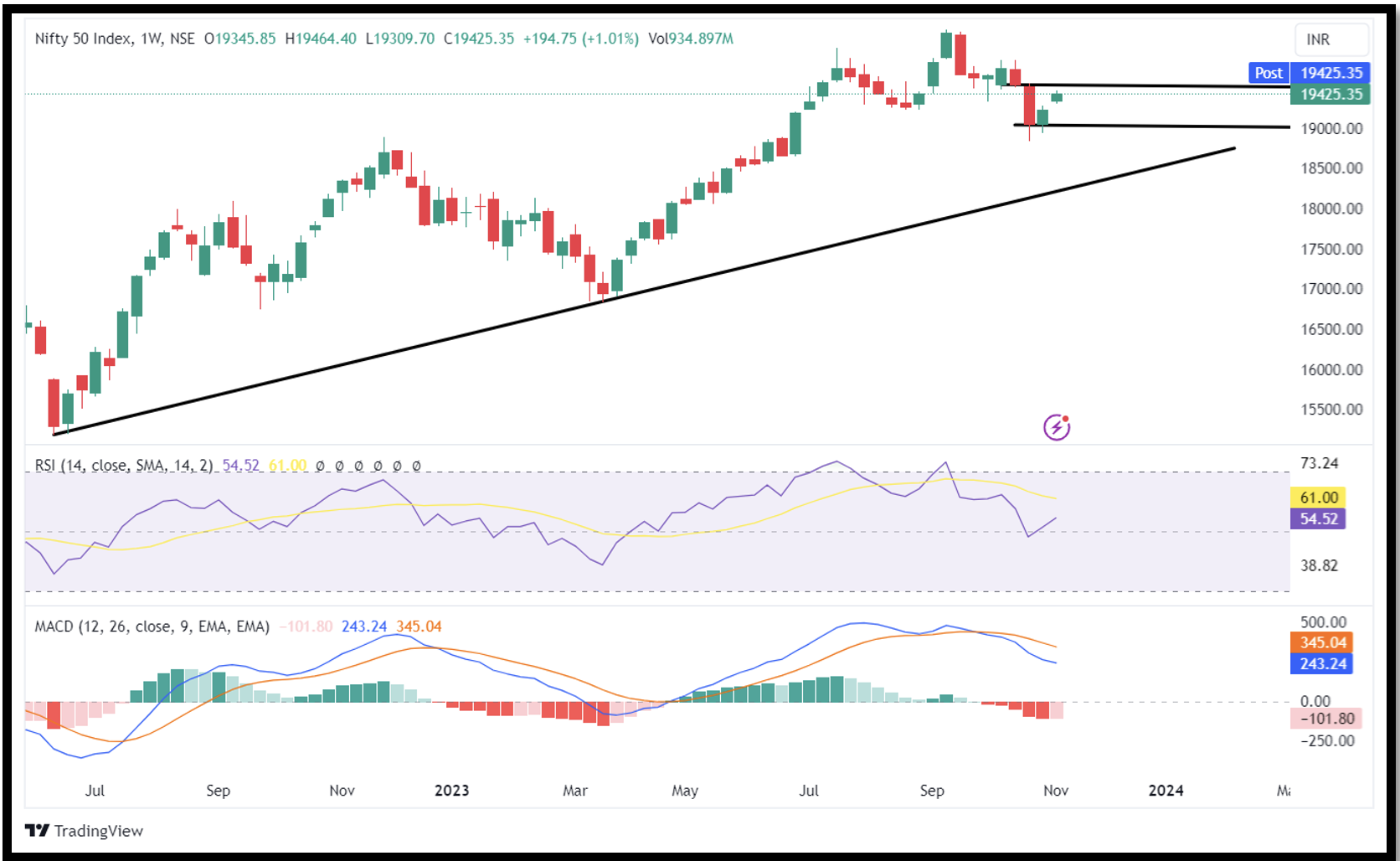Stock Market Updates for November, 2023
24th November, 2023
Investing Realities: Focusing Beyond Returns
We all know how India showcased its prowess in the 2023 ODI World Cup by staying unbeaten until the final match against Australia last week. Winning a match in cricket requires the team to focus on skill, strategy, teamwork, and adaptability. However, the outcome is never in the hands of the players.
This echoes a sentiment familiar to investors in the stock market. Investors often fixate on the end result i.e. returns while neglecting the critical factors that are within their control namely risk, cost, time, and emotion.
In both cricket and investing, the tricky part is feeling like you're in charge when, in reality, some things are beyond your control. Cricket teams make plans, but things like weather and how well the opponent plays can change everything. Similarly, investors can study stocks, but the ups and downs of the market, global events, and economic changes are not something they can control. Now, let's take a closer look at the usually overlooked factors of risk, cost, time, and emotion, and see how they can affect the results of your investments.
Finding the Right Balance between Risks and Returns: Investing in the stock market is like walking a tightrope; you need to balance making money with being careful not to lose it all. Central to this balancing act is the concept of position sizing, which involves determining the appropriate number of shares or the amount of investment in a specific security. With a motive to earn higher returns, investors frequently overlook diversification and position sizing. For example, an investor has Rs. 1,00,000 and focuses on an investment that is expected to generate 20% returns within a month. By focusing on returns, he will tend to invest majority of his funds in that scrip thereby increasing his risk appetite. In essence, the wisdom lies not only in seeking gains but in creating a defensive playbook against market volatility.
Watch out for sneaky costs: Transaction costs, management costs, and taxes can quietly take away the profits earned from investments. For instance, consider an investor who achieves a 20% return on an investment amount of Rs. 1,00,000. However, he executes numerous trades resulting in costs exceeding the returns. Investors must keep an eye on their costs to make sure they don’t end up losing more than they gain.
Time is more than just a clock ticking: Chasing quick profits might sound thrilling, but investors should understand that it is not always about getting rich overnight. Investors must emphasize the principle of spending time in the market rather than trying to time the market perfectly. Beyond just how long you invest, it's equally important to pay attention to when you enter and exit the market. It's a common occurrence for investors to jump into trades when stock valuations are high and undergoing a rally, hoping for a further surge in stock prices. On the flip side, they also tend to bail out of stocks too early, missing out on potential gains. Both of these situations contribute to investors making suboptimal choices, ultimately limiting the profits they could have earned.
Navigating the Human Element: Emotions play a significant role in investing, more than you might think. Feeling scared or greedy can lead to quick decisions that might hurt your finances. It's a bit like staying calm in cricket, avoiding the "Leg before Wicket" situation of making impulsive decisions. Keeping emotions in check is crucial for making wise choices in your investments.
Similar to how cricket teams can't determine the outcome of a match, investors can't fully control the returns on their investments. Taking a cue from the 2023 ODI World Cup, it's clear that, in both cricket and investing, the journey is as crucial as the destination. Instead of fixating on returns that are beyond their control investors should focus on aspects they can manage, such as risk, cost, time, and emotions. This shift in focus empowers investors to make informed decisions within their sphere of influence.
Technical Outlook

In a weekly wrap, the Nifty inched higher by 0.30% and ended at 19,790.55.
Throughout the entire week, the Nifty persistently attempted to break the critical resistance threshold of 19,900 yet each attempt turned into a sell-off. However, further consolidation in as it trades within the price range, setting the stage for the next breakout. This sets the stage for a more aggressive breakout. A weekly close above the last high indicates greater strength.
50 SMA plots around 19,580 which would remain weekly support while resistance is placed at 20,000 followed by 20,100.
17th November, 2023
Nifty 50’s Earnings Cup: Key Highlights for September Quarter!
The earnings season for India Inc.'s second quarter of fiscal year 2023-24 has concluded, revealing a tapestry of performances across sectors within the Nifty50.
_1700226354.jpg)
The aggregate revenue of Nifty50 soared 9% YoY to an impressive Rs 11.38 lakh crore, accompanied by a robust 20% YoY surge in profits to Rs 1.50 lakh crore. The underlying strength of the Indian economy was further underscored by 36 out of 50 companies reporting growth in revenues, and 40 companies recording increased profits.
The standout feature of this earnings season has been the expansion of margins by 694 basis points YoY, reaching a remarkable 30.14% for the quarter. This was propelled by the strategic benefit reaped from the decline in input costs.
Sectoral Standouts:
_1700226355.jpg)
The banking sector exhibited an in-line performance in Q2FY24 driven by advances growth and consistent enhancements in asset quality. Nevertheless, the margin trajectory faced further compression, primarily due to an increase in funding costs. While retail and MSME sectors showed strong credit growth, the corporate book also witnessed an uptick. Deposit growth, led by term deposits, resulted in a sustained decline in the CASA ratio. At an industry level, the credit-to-deposit ratio is at its highs, and therefore the banks who will be able to demonstrate a sustained increase in deposits would be at an advantage. Nevertheless, the Net Interest Margins (NIM) are expected to see a further decline for banks with a high floating rate. However, the overall outlook for banks remains positive, with mid-teen credit growth expected to persist, and medium-term asset quality remaining stable.
The auto sector witnessed a healthy performance, propelled by corrections in raw material prices and cost efficiencies. The key catalyst contributing to the sector's success includes initial signs of revival in the 2-wheeler industry, an increase in economic activities bringing cheers to the commercial vehicles, and a surge in the sales volume of SUVs in the Passenger Vehicle mix. Focus on premiumization, new order wins, operating leverage, and favorable foreign exchange has been fruitful for the companies. The sector anticipates gradual improvement in exports, setting the stage for a strong show in the future.
Contrary to the usual weak seasonal trend, the Realty sector stole the limelight in Q2FY24. Real estate companies exhibited a remarkable recovery in property demand. Factors such as a rich product mix, new project launches, commodity tailwinds, and stability in interest rates drove the momentum. Encouraging sales figures are expected to continue, driven by increasing demand for branded developers, particularly in the premium housing segment.
The IT sector witnessed a dull September quarter with modest revenue and profit growth. Delays in discretionary spending and decision-making, the decline in attrition rates, and noteworthy deal wins were some of the key attributes of the quarter gone by. Certain pockets, especially midcap IT companies, performed well. Despite the challenges, the TCV remains strong which should propel the long-term positive view for the IT sector.
FMCG faced challenges in revenue growth due to rural stress and erratic monsoon, resulting in unstable demand. However, companies reported margin expansion due to a moderation in input prices, boosting overall profitability. The sector looks forward to volume-led growth and a recovery in rural demand to lift its performance in the coming quarters.
The pharma sector garnered enthusiasm with positive market sentiment, while the metals sector weighed down the earnings performance, facing headwinds.
The resilient performance of Nifty50 in Q2FY24 is not just a reflection of the past but a promising indicator for the future trajectory of the Indian economy. Green shoots indicate that the strong demand environment is here to stay, thanks to the revival in the investment cycle and increasing capacity utilization. Therefore, domestic-oriented themes are set to dominate our country. The positive outlook for sectors such as banking, automobiles, cement, capital goods/EPC, and pharmaceuticals positions India Inc. for sustained growth in the coming years.
Technical Outlook
_1700226355.jpg)
Nifty50 closed robustly at 19,732, posting a 1.06% gain in the week. Meanwhile, the Nifty500 also soared by 2%, showcasing the collective strengthening of midcap and small-cap segments. Also, in Nifty50 constituents, Eicher Motors emerged as the top gainer, up 9% while Axis Bank dragged by 3.55%.
Technically, a daily chart breakout from the downward trendline and sustained positions above key moving averages (20 and 50 DMA) signify bullish momentum. RSI at 60 indicates a balanced market. Weekly volume profiles establish 19,400 as robust support and 20,050 as significant resistance.
The Index has multiple resistance around the 19,850 levels and chances of a further up move will depend on the option activity at the maximum call open interest strike of 19,800.
We anticipate that Nifty IT, Auto, and Pharma will continue performing well, as demonstrated by the strength of their respective indices.
Throughout the week, the Nifty50 consistently opened with notable gaps, and challenges for traders, necessitating a prudent hedging strategy for overnight positions.
11th November, 2023
FIIs to make a U-Turn in Indian Markets
Foreign Institutional Investors (FIIs) have been on a selling spree in the Indian markets, pulling out their money for 9 weeks in a row. In fact, this is the 3rd largest selling streak by FIIs since the year 2000. They have withdrawn Rs. 39,794.6 crores in this streak.
What does this mean for the Indian markets?
Historically, it has been observed that whenever FIIs have net withdrawn for 5 or more consecutive weeks, the Indian markets tend to fall. Since 2000, there have been 12 instances where FIIs have pulled out money for 5 or more successive weeks. Of these, the Nifty50 index has fallen 9 times, with an average loss of 9.23%.
However, this time around markets have held their ground and fallen only 3% from September 8 to November 03, 2023.

But what drives the FII selling?
The withdrawal from FIIs can be attributed to a rise in the US 10-year Bond Yields. During the Covid-19 pandemic, these bonds yielded less than 1%. But as inflation soared, the Federal Reserve hiked the interest rates, ferreting the bond yields to a record level last seen during the Global Financial crisis in 2008.
How do these US Bond Yields impact the Indian Indices?
For FIIs, bonds are an alternative investment option to lower their risk. As the Fed hikes the interest rates, bond prices decrease and the yields increase. This increase in the bond yields leads FIIs to shift their investing paradigm from equity to debt markets. Historically, FII selling tends to occur during periods of rising US bond Yields. Quite sporadic, there have been only 3 instances where the selling spree of FIIs continued while US bond yields fell.
The future of this FII selling spree remains uncertain. However, a fortnight ago, the US Fed held onto the interest rates for the second consecutive time. This decision caused the US bond yields to cool off a bit. Furthermore, the Fed’s dovish comments this time cheered the markets as interest rates are expected to sustain at current levels. With inflation slowing down, there could be a cut in the interest rates too. In turn, the bond yields will begin to fall, making FIIs flock back to Indian Markets. Further, the FII withdrawals for the past week have not been as severe as seen in the previous weeks, suggesting that the momentum in FII withdrawals is slowing down.
Empirical data suggests after the end of the FII selling spree, the Nifty50 has on average risen 3.46% in just 1 month and 4.86% in the next 2 months. Furthermore, whenever the index falls 5% or more, the bounce back generally tends to be significantly superior. It remains to be seen how the Nifty50 reacts after the selling streak is broken.
Technical Outlook

The Nifty50 index has been consolidating around the 19,300-19,500 range since last four trading sessions. The put writers further strengthened their position at the maximum put open interest strike of 19,300 in Nifty. Both the writers fought it out at the 19,400 Strike with call writers marginally ahead of the put writers at the end of today’s close. The option activity at 19,400 Strike will provide cues about Nifty’s Intraday direction on Monday.
Bank Nifty has been consolidating in the 43,400-43,800 range since last five days. A decisive breakout on either side of the range will provide cues about Bank Nifty’s future direction. The maximum put open interest for Bank Nifty, which is placed at 43,500 Strike, will act as a strong support for the Index.
3rd November, 2023
Investing Lessons from the World Cup 2023
_1699011671.png)
The scoreboard of the ICC World Cup of 2023 seems to be analogous to that of the thought process of an investor. England being the defending champions of 2019 has underperformed in the World Cup series of 2023. In the world of capital markets if England was a portfolio that topped the performance charts in 2019 is struggling at the bottom in 2023.
Past performance certainly does not guarantee future results whether on a playground or in markets. Several elements can affect the performance of stocks or cricket teams.
The majority of players in England's squad in 2019 are also in 2023 but their performance has tumbled which may be because of players' age, agility, etc.
Similarly, the performance of a portfolio also depends upon several headwinds such as interest rates, inflation, management’s intentions and ability to capitalize on opportunities, market growth, competition, etc.
In simple terms, the factors determining the performance in two different periods are never the same. So, Investments based on past performance may not yield similar results in the future always.
This tendency to invest based on past performance is a type of behavioral bias commonly termed trend-chasing or extrapolation bias.
Many investors pursue stocks based solely on past performance, assuming these returns are achievable in the future. Yet, research indicates this strategy is unreliable, as historical gains often don't foreshadow future success.
Now the question arises how do you overcome this bias?
First is education. Research empowers investors to grasp fundamental principles, gain a competitive edge, stay informed, and acknowledge and overcome their biases. This fosters independent thinking, helping them overcome two behavioral tendencies of chasing trends - fear of missing out or fear of joining a rally. Investors can maintain a clearer perspective on their market positions and make more rational decisions.
Earnings and share price returns of tech companies and housing companies were on an upsurge before the dot com bubble and housing market crash respectively. Investors should assess the risks associated with trendy investments before investing in specific themes.
A simple diversified approach would act as a hedge in the falling markets. Diversification helps in addressing both systematic risks and unsystematic risks, prudent allocation towards the different categories of asset classes is much more likely to sail through the storms in the markets when you are struck with Black Swan events like these.
Investors should be cautious of peer influence and avoid making investments solely based on their suggestions or recommendations. and should be aware of the “wisdom of the crowd” surrounding them before making an irrational decision that forces them to book losses in the future. If required investors can use the help of certified professionals.
Avoiding this trend-chasing bias also leads to a different style of investing - contra investing. Where contrarian investors may see opportunities in undervalued assets that others are selling, ultimately profiting when the market resumes. Further, quantitative analysis and techniques can also be used for investing without focusing on the noise of the herd.
Investors can also consider holding cash instead of blindly following trends to avoid potential disappointment. They need to be aware of methods to overcome trend-chasing bias and periodically rebalance their portfolios.
Just as in cricket, shifting investments from England's 2019 squad to India's 2023 squad for better returns, protection against downward risks, flexibility, and a well-thought-out strategy are key to success in financial markets.
Technical Outlook
_1699011670.png)
The majority of stocks in Nifty are on track for noteworthy gains so far this week, ended at 19,230.60 pushing the index 0.96 % higher.
As the Fed kept the rate unchanged, the global market rallied swiftly followed by the Indian market.
Among Nifty participants, BPCL outperformed with a 7.93% gain while M&M remained the top loser with a loss of 2.77% in a week.
Among sectors, Nifty Realty outshines with a 10.42% gain while Nifty Auto ended marginally lower.
Technically, in the weekly chart, a Bullish inside candle is formed. While weekly RSI remains at 51. While on a daily chart, 50 DMA placed 19450 acting as strong resistance. In the Monthly expiry, on the call side, the maximum concentration remains at the 19500-strike price while on the put side 19,000 has the highest concentration.
The exact range for the upcoming weekly would be 19000-19550, but a break of either side would derail the range-bound rally.
Alternatively, the prices of gold and crude have already rallied, and as they cool down, this could result in favorable triggers for benchmark indices. Yet, the performance of IT and Private Banks is pivotal for sustained growth. Investors must withstand minor hiccups and maintain a long-term view amid potential sector-specific challenges.

 Easy & quick
Easy & quick